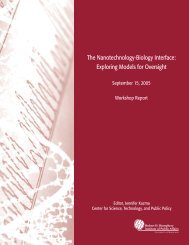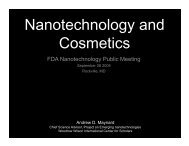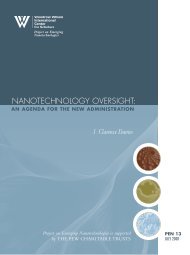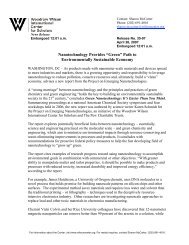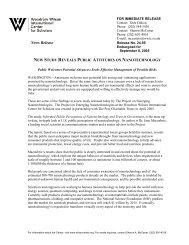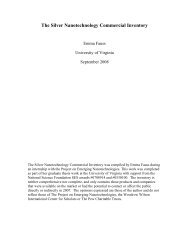Analysis of Nanotechnology from an Industrial Ecology ... - denix
Analysis of Nanotechnology from an Industrial Ecology ... - denix
Analysis of Nanotechnology from an Industrial Ecology ... - denix
Create successful ePaper yourself
Turn your PDF publications into a flip-book with our unique Google optimized e-Paper software.
DRAFT - Inventory <strong>an</strong>d Evaluation <strong>of</strong> Life Cycle Assessments <strong>of</strong> N<strong>an</strong>otechnologies<br />
provide clues to environmental benefits <strong>an</strong>d impacts <strong>of</strong> n<strong>an</strong>otechnologies. For inst<strong>an</strong>ce, because<br />
n<strong>an</strong>omaterials facilitate dematerialization, I expected the life cycle assessments to show certain<br />
environmental benefits (e.g., less energy consumption, less emissions <strong>from</strong> tr<strong>an</strong>sportation, less<br />
material waste generated at end-<strong>of</strong>-life). I expected that energy use, although lower during use<br />
<strong>of</strong> a n<strong>an</strong>o-based product, may be higher during production as compared to a conventional<br />
product. In addition, I <strong>an</strong>ticipated that the existing life cycle assessments would evaluate a r<strong>an</strong>ge<br />
<strong>of</strong> product types <strong>an</strong>d address all life stages, but also reveal some gaps (e.g., toxicity <strong>of</strong><br />
n<strong>an</strong>omaterials because so little toxicological research has been performed). The findings <strong>from</strong><br />
this research may be useful for informing future life cycle assessments <strong>of</strong> n<strong>an</strong>otechnologies,<br />
particularly to better underst<strong>an</strong>d where gaps remain, which methods <strong>an</strong>d data sources proved<br />
useful, <strong>an</strong>d where we should direct future research efforts.<br />
3. Methodology<br />
To carryout this research, I first reviewed n<strong>an</strong>omaterial market penetration across product<br />
categories <strong>an</strong>d sectors. I then performed a literature review <strong>of</strong> life cycle assessments on<br />
n<strong>an</strong>otechnologies. Using the internet, libraries, <strong>an</strong>d articles submitted to the Journal <strong>of</strong> <strong>Industrial</strong><br />
<strong>Ecology</strong>, I tried to identify existing LCAs on n<strong>an</strong>o-based products. I also contacted various<br />
experts in the fields <strong>of</strong> n<strong>an</strong>otechnology, industrial ecology, <strong>an</strong>d life cycle assessment for<br />
information.<br />
4. Overview <strong>of</strong> <strong>N<strong>an</strong>otechnology</strong> Market Penetration<br />
N<strong>an</strong>omaterials have already entered m<strong>an</strong>y product lines <strong>an</strong>d industries. Because <strong>of</strong> this existing<br />
<strong>an</strong>d the potential penetration <strong>of</strong> n<strong>an</strong>otechnologies into the marketplace, both the positive <strong>an</strong>d<br />
negative impacts will be far-reaching. To quote Cientifica’s projection in 2003:<br />
“n<strong>an</strong>otechnology will affect almost every market either directly or indirectly.” The sectors with<br />
n<strong>an</strong>o-scale products in use or in development include the following: automotive, chemical,<br />
construction, cosmetics, electronics, energy, engineering, environmental, food <strong>an</strong>d drink,<br />
household, medicine, sports, textiles, <strong>an</strong>d warfare (VDI 2004, Hood 2004). Products derived<br />
<strong>from</strong> n<strong>an</strong>otechnologies reside in everything <strong>from</strong> sunscreens to tennis rackets to solar p<strong>an</strong>els to<br />
water decontamination devices. A book by Uldrich <strong>an</strong>d Newberry 2003 suggests that the top ten<br />
industries (in terms <strong>of</strong> billions <strong>of</strong> dollars <strong>of</strong> investment) that will be revolutionalized by<br />
n<strong>an</strong>otechnology include healthcare, long-term care, electronics, telecom, packaging, chemical,<br />
plastics, apparel, pharmaceutical, <strong>an</strong>d tobacco. Roco 2003 indicates <strong>an</strong>nual n<strong>an</strong>o-sales <strong>of</strong> $1<br />
trillion in ten years including $340 billion for materials, $300 billion for electronics, $180 billion<br />
for pharmaceuticals, $100 billion for chemical catalysts <strong>an</strong>d processing. Table 1 provides a list<br />
<strong>of</strong> some <strong>of</strong> the applications <strong>of</strong> n<strong>an</strong>otechnology. 3<br />
Materials produced at the n<strong>an</strong>o-scale take various forms. The Royal Society categorizes<br />
n<strong>an</strong>omaterials by dimension as follows:<br />
• One dimension: surface coatings <strong>an</strong>d films;<br />
• Two dimensions: n<strong>an</strong>owires, n<strong>an</strong>otubes, biopolymers;<br />
3 AZoN<strong>an</strong>o.com, <strong>an</strong> online warehouse <strong>of</strong> n<strong>an</strong>otechnology information (“the A to Z <strong>of</strong> <strong>N<strong>an</strong>otechnology</strong>”) also<br />
provides a lengthy list <strong>of</strong> n<strong>an</strong>o-based product applications (2005).<br />
5



